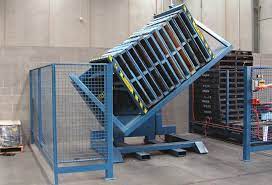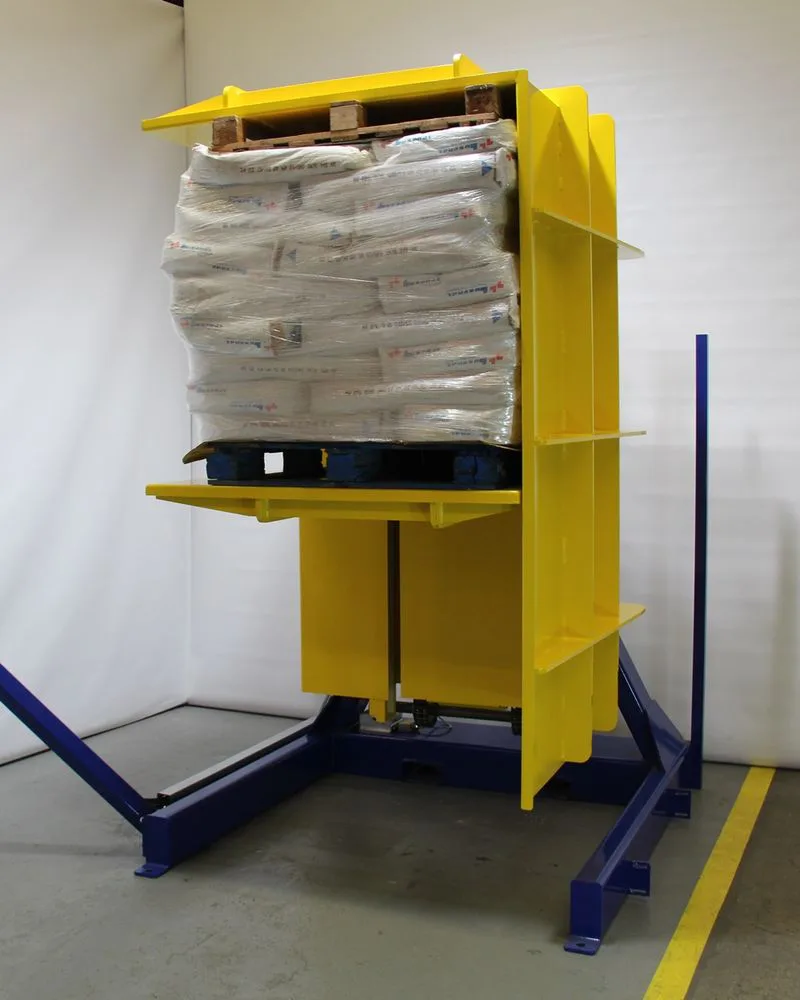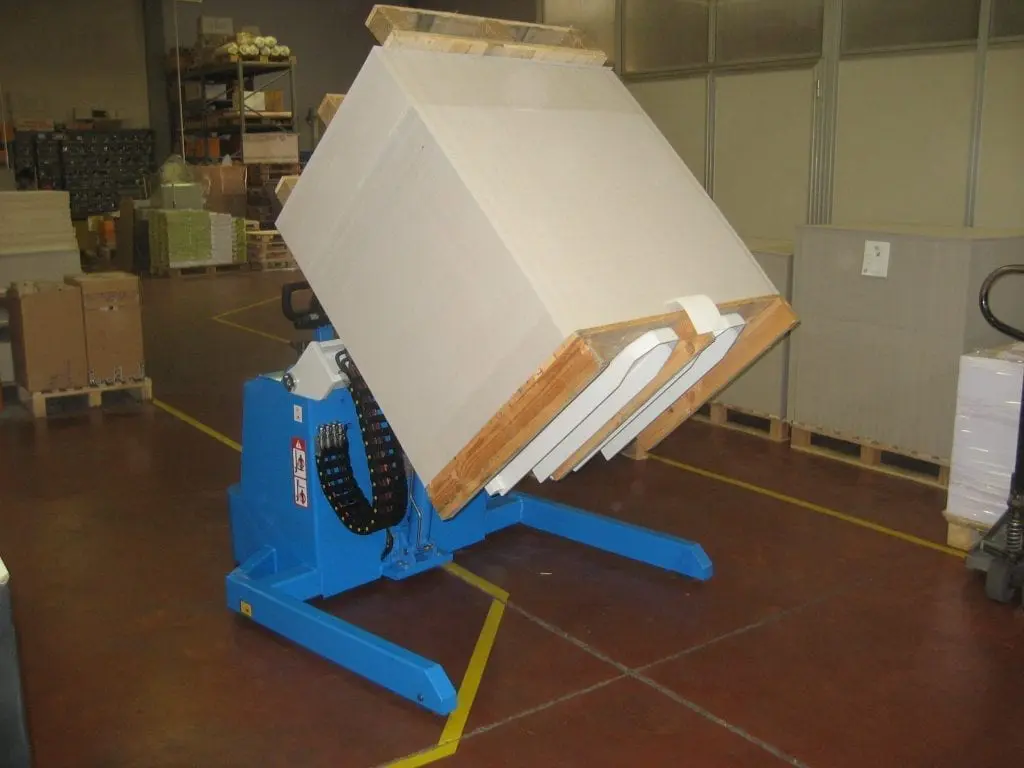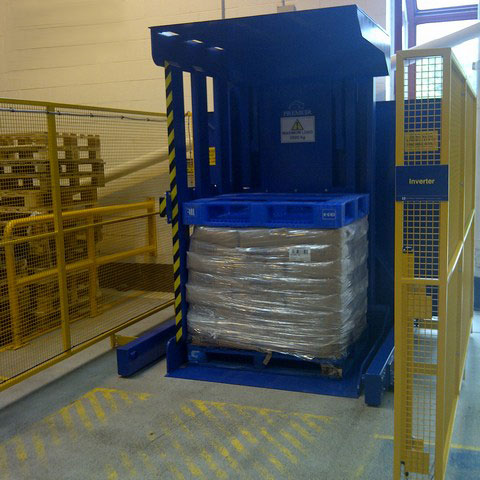Pallet Inverter: How to Ensure Operator Safety When Rotating Engine Block Pallets?
Handling heavy and irregularly shaped loads like engine blocks presents a significant challenge on any factory floor. You might be using cranes or forklifts with special attachments, but these methods are often slow and introduce a high risk of human error. I've seen situations where a slightly unbalanced lift or a moment of inattention leads to a dropped engine block. This not only destroys a high-value product but, more importantly, puts your operators in grave danger. The pressure to maintain speed while ensuring safety is immense, and a single accident can lead to devastating injuries, production halts, and serious financial consequences. It’s a constant worry for any responsible manager or owner.
To ensure operator safety when rotating engine block pallets, you must implement a multi-layered strategy. This involves selecting a pallet inverter with robust mechanical safety features like physical guarding and redundant clamping systems, integrating smart control systems with fail-safes and programmed sequences, and enforcing strict operational procedures, including comprehensive operator training and rigorous maintenance schedules. Safety is not a single feature; it is an engineered and managed system.

I’ve spent over two decades in the packing machine industry, first as an engineer and now as a factory owner. I know the weight of responsibility that comes with managing a team and heavy machinery. The safety of my people is always my first priority. An unsafe operation is an inefficient and unprofitable one. A pallet inverter is a fantastic tool for efficiency, but its true value is only realized when safety is built into its very design and operation. In this article, I want to share my practical insights on the critical aspects of pallet inverter safety, moving from the machine's hardware to its control system and the people who use it. Let’s break down how you can create a truly safe environment for handling heavy loads like engine blocks.
What are the most critical mechanical safety features for a pallet inverter?
You're considering a new pallet inverter. You see the thick steel and the powerful hydraulics, and it looks impressive. But as an engineer, I know that true safety lies in the details you can't always see at first glance. A weak weld, a single point of failure in the clamping system, or an exposed moving part can turn a powerful machine into a serious hazard. The thought of a multi-ton engine block slipping because a hydraulic valve failed is something that should concern every plant manager. The solution is to look past the paint and scrutinize the core mechanical safety features that separate a truly safe machine from a potential liability.
The most critical mechanical safety features for a pallet inverter are physical barriers and guarding, a redundant and fail-safe clamping system, and superior structural integrity. Physical fences with interlocked gates prevent accidental entry during operation. A clamping system with dual hydraulic cylinders and check valves ensures the load remains secure even if one component fails. Finally, the machine’s frame must be built from high-tensile steel with certified welds to handle the specified load without fatigue or failure over its lifespan.

In my early days as an engineer, I was tasked with investigating a competitor's machine failure. The incident was minor, with no injuries, but the cause was chilling. A single hydraulic hose failed, and the clamping pressure dropped just enough for the load to shift and get damaged. The machine lacked a simple check valve that would have held the pressure. That experience taught me that redundancy isn't a luxury; it's a necessity. When we design machines at SHJLPACK, we build them based on the principle that failure is always a possibility, so we must engineer systems to ensure that if one part fails, another takes over to maintain a safe state. Let's dive deeper into the specific mechanical features you must demand from your equipment supplier.
Physical Guarding and Barriers
The first line of defense is always a physical barrier. A running pallet inverter has powerful moving parts and immense clamping force. An operator who accidentally steps into the operational area is at extreme risk. Relying on painted lines on the floor is not enough.
A robust safety system starts with perimeter fencing. This should be high enough to prevent someone from easily reaching over it. More importantly, any access gate must be equipped with a safety interlock switch. This switch is wired directly into the machine's safety circuit. If the gate is opened, the machine must immediately stop all motion. This is non-negotiable. Some modern systems also use light curtains. These project a beam of infrared light across the machine's opening. If an operator's hand or body breaks the beam, the machine stops instantly. This is excellent for applications where frequent loading and unloading make a physical gate cumbersome.
The Clamping System: Your Load's Lifeline
The system that holds the engine block is the most critical safety component. For a heavy and high-value load, a single clamping cylinder is a major red flag. A proper design uses dual hydraulic cylinders. This provides redundancy; if one cylinder or its hose fails, the other can still hold the load securely.
Furthermore, each cylinder must have a pilot-operated check valve or a pressure-holding valve installed directly on it. This small device acts as a one-way gate for the hydraulic fluid. It locks the fluid in the cylinder, maintaining clamping pressure even if a hose bursts or the main power fails. The clamping plates themselves should also be considered. They need a large surface area to distribute pressure evenly and should be faced with a high-friction material, like durable rubber, to grip the pallet and load without causing damage.
Structural Integrity and Stability
A machine is only as strong as its foundation. The frame of the pallet inverter must be designed to handle not just the static weight of the load but also the dynamic forces generated during rotation.
Here’s what to look for:
- Material: Ask for the steel specifications. A machine built with high-tensile steel (like Q345) will be stronger and more durable than one made with standard mild steel (like Q235).
- Welding: Welds should be clean, continuous, and performed by certified welders. Poor-quality welds are common points of failure under stress.
- Base Frame: The machine's base must be wide and heavy to provide a low center of gravity. This prevents any possibility of the machine tipping over, even with the heaviest and highest-rated load at full extension.
| Feature | Basic (Low-Cost) Implementation | Advanced (Safety-First) Implementation | Impact on Safety |
|---|---|---|---|
| Guarding | Painted lines on the floor | Full perimeter fencing with interlocked gates | Prevents accidental entry into the danger zone. |
| Clamping System | Single hydraulic cylinder | Dual cylinders with pilot-operated check valves | Provides redundancy; holds load if one system fails. |
| Frame Material | Standard mild steel (Q235) | High-tensile structural steel (Q345) | Higher strength, better resistance to fatigue and stress. |
| Emergency Stop | Basic stop button | Redundant, hard-wired safety circuit (Cat 3/4) | Ensures reliable shutdown in any emergency. |
How do control systems and automation enhance operator safety?
You have a mechanically sound pallet inverter. It's built like a tank. But in the hands of an untrained or distracted operator, even the strongest machine can be used unsafely. An operator might try to rotate a load before it's fully clamped, or open a safety gate while the machine is moving. These human errors are a major source of industrial accidents. This is where a smart control system turns a powerful tool into a safe, collaborative partner. Imagine a machine that simply won't allow an unsafe command to be executed.
Control systems and automation enhance operator safety by enforcing a strict, pre-programmed sequence of operations. A Programmable Logic Controller (PLC) ensures that prerequisites, like confirmed clamping pressure and closed safety gates, are met before allowing the next step, such as rotation, to begin. This removes the possibility of critical human error. Features like two-hand controls and integrated sensors provide further layers of protection, making the machine an active participant in its own safe operation.

When I first started my factory, I invested in automation not just for productivity, but for consistency and safety. I learned that a well-programmed machine is the most reliable employee you can have. It never gets tired, it never gets distracted, and it follows the safety rules every single time. For a pallet inverter handling something as valuable and heavy as an engine block, the control system isn't just a feature—it's the brain that protects both the operator and the product. Let's explore how these systems provide a level of safety that mechanical features alone cannot achieve.
The PLC: The Brain of the Operation
The heart of a modern pallet inverter's control system is the PLC. This industrial computer is programmed with a specific logic that cannot be easily bypassed. It functions like a strict supervisor, checking off a list of conditions before allowing any action.
Here's a typical safe sequence enforced by a PLC:
- System Ready: The PLC checks that all safety gates are closed and all emergency stops are reset.
- Load in Position: Sensors confirm that the pallet is correctly positioned on the loading platform.
- Clamping: The operator presses the 'Clamp' button. The PLC activates the hydraulic system.
- Pressure Confirmation: Pressure switches or sensors send a signal back to the PLC confirming that the required clamping force has been reached and is stable.
- Rotation Enabled: Only after receiving this confirmation will the PLC enable the 'Rotate' function. If the operator tries to rotate before clamping is complete, nothing will happen.
- Rotation and Re-clamping: The machine rotates. The process is reversed with the same safety checks.
This automated sequence control is fundamental. It removes the burden of critical decision-making from the operator during the machine's cycle, drastically reducing the chance of an accident caused by a mistake or a shortcut.
Active Safety Controls and Sensors
Beyond the core PLC logic, several other control features actively protect the operator.
- Two-Hand Controls: For initiating key movements like clamping or rotating, many systems require the operator to press two buttons simultaneously. The buttons are spaced far enough apart that one hand cannot press both. This ensures the operator's hands are on the control panel and safely away from the machine's moving parts during operation.
- Emergency Stop (E-Stop) Circuits: This is more than just a red button. A true safety E-stop is a hard-wired circuit that is independent of the PLC. When pressed, it cuts power directly to the machine's motors and hydraulic pumps, guaranteeing a shutdown even if the PLC software fails. These circuits should be designed to a specific safety category (e.g., Category 3 or 4), which dictates the level of redundancy and fault monitoring.
- The Human-Machine Interface (HMI): A modern HMI (a touchscreen or display panel) provides clear communication. It shows the machine's current status, displays any error messages in plain language ("Safety Gate 2 Open"), and provides diagnostic information. This empowers the operator and maintenance staff to understand what the machine is doing and to troubleshoot problems quickly and safely.
| Control System Feature | Description | How It Enhances Safety |
|---|---|---|
| PLC Sequence Control | The machine's actions are controlled by a pre-programmed logic. | Prevents out-of-sequence operations, like rotating before clamping. |
| Two-Hand Controls | Requires the operator to use both hands to start a machine cycle. | Ensures the operator's hands are in a safe location, away from moving parts. |
| Safety Interlocks | Switches on gates and guards that are wired into the safety circuit. | Immediately stops the machine if a physical barrier is opened. |
| Pressure Sensors | Monitors the hydraulic pressure in the clamping system. | Confirms the load is securely held before allowing rotation; prevents slippage. |
| HMI Diagnostics | A screen that displays status, warnings, and error messages. | Reduces operator error and allows for faster, safer troubleshooting. |
What operational procedures and training are essential for safe pallet inverter use?
You can invest in the best-engineered pallet inverter on the market, one with flawless mechanical features and an intelligent control system. But if the person operating it doesn't understand the risks or know the correct procedures, you still have a significant safety gap. I've seen beautifully maintained machines cause incidents simply because of a lack of operator discipline or knowledge. The assumption that anyone can run a "simple" machine is a dangerous one. A culture of safety isn't bought; it's built through rigorous procedures and continuous training.
Essential operational procedures for safe pallet inverter use include mandatory pre-shift inspections, clearly defined operating and exclusion zones, and strict lockout/tagout (LOTO) protocols for all maintenance and cleaning tasks. This must be supported by a comprehensive training program that goes beyond basic operation to cover emergency procedures, risk awareness, and machine-specific maintenance checks, culminating in operator certification.

There’s a story I often tell my new engineers. Early in my career, a seasoned mechanic at a client's factory lost the tips of two fingers. He was trying to clear a small jam on a conveyor without shutting the power down completely. He had done it a hundred times before. He knew the LOTO procedure, but he took a shortcut to save a few minutes. That day, his luck ran out. That incident cemented my belief that procedures and training are just as important as the engineering of the machine itself. A piece of paper with a procedure on it is useless if it isn't followed every single time.
Developing Standard Operating Procedures (SOPs)
An SOP is a written, step-by-step instruction for operating the pallet inverter. It removes ambiguity and ensures every operator performs the task in the same, safe way. Your SOP should be clear, concise, and readily available at the machine.
Key elements of a strong SOP for a pallet inverter include:
- Pre-Shift Inspection Checklist: A simple list of items the operator must check before starting their shift. This includes checking for hydraulic leaks, verifying that guards are in place, testing the E-stop button, and ensuring the area is clear of obstructions.
- Loading and Unloading Procedure: Specific instructions on how to approach the machine with a forklift, where to place the pallet, and how to verify it is seated correctly before starting the cycle.
- Normal Operation: Step-by-step guide on using the controls for a standard rotation cycle.
- Emergency Procedures: What to do if the machine stops mid-cycle, if a load shifts, or if the E-stop is activated.
- Shutdown Procedure: The correct sequence for powering down the machine at the end of a shift.
The Non-Negotiable: Lockout/Tagout (LOTO)
Any task that requires an employee to place any part of their body into a machine's danger zone—for maintenance, cleaning, or clearing a jam—must be performed under a strict LOTO procedure. This is a critical OSHA requirement in the US and a best practice globally.
LOTO is more than just hitting the E-stop. It involves:
- Isolating the Energy Source: The machine must be completely de-energized at the main electrical disconnect.
- Applying a Lock: The person performing the work places their personal lock and tag on the disconnect, so it cannot be turned back on.
- Verifying De-energization: The worker must then try to start the machine to verify that the power is truly off. They must also release any stored energy, like hydraulic pressure.
Every authorized employee should have their own lock and key. A culture where LOTO is followed without exception is a sign of a truly safe workplace.
Comprehensive Training and Certification
Training should not be a one-off event. It needs to be a structured program.
- Initial Training: Classroom-style learning covering the SOP, the machine’s specific risks, and the LOTO procedure. This is followed by hands-on, supervised training with an experienced operator.
- Certification: After demonstrating proficiency, the operator is formally certified to use the machine. Keep a record of who is certified.
- Refresher Training: Conduct annual refresher courses to reinforce safe practices and introduce any new procedures.
- Incident Review: If a near-miss or minor incident occurs, use it as a training opportunity for the entire team to understand what went wrong and how to prevent it in the future.
| Training Component | Description | Objective |
|---|---|---|
| Classroom Session | Review of the machine manual, SOPs, and safety risks. | To provide foundational knowledge before hands-on operation. |
| Supervised Operation | One-on-one training with a certified mentor on the factory floor. | To build practical skills and confidence in a controlled environment. |
| LOTO Training | Specific, hands-on training on the lockout/tagout procedure. | To ensure competence in safely de-energizing the machine for maintenance. |
| Operator Certification | A formal test of knowledge and practical skills. | To verify and document that the operator is qualified to run the machine safely. |
How does choosing the right pallet inverter impact long-term ROI and maintenance costs?
As a factory owner, every equipment purchase comes down to numbers. It's easy to look at two quotes for a pallet inverter and be tempted by the lower price tag. This seems like a quick win for your budget. But I’ve learned, sometimes the hard way, that the initial purchase price is only a small part of the machine's true cost. A cheap machine that constantly breaks down, requires frequent service, or worse, causes a safety incident, will end up costing you far more in downtime, repairs, and potential liabilities than you ever "saved" on the initial purchase.
Choosing the right pallet inverter has a direct and significant impact on long-term ROI by minimizing the total cost of ownership. A high-quality, reliable machine with robust safety features reduces costly production downtime, lowers annual maintenance and repair expenses, and prevents catastrophic financial losses from accidents and product damage. The higher initial investment pays for itself through superior operational stability and peace of mind.

I always advise my clients to think like an owner, not just a purchaser. When you look at a machine, don't just see the price. See the thousands of cycles it will perform, the value of the product it will handle, and the operators whose safety depends on it. A machine that runs reliably for 15 years with minimal maintenance is a far better investment than one that saves you 20% upfront but becomes a headache in year two. This is about investing in uptime, safety, and predictability for your business. Let's analyze how a quality-focused decision pays dividends.
Calculating the Total Cost of Ownership (TCO)
The sticker price is just the beginning. To make a smart investment, you must consider the TCO over the machine's expected lifespan (e.g., 10-15 years).
TCO = Purchase Price + (Annual Maintenance Costs + Annual Downtime Costs + Annual Energy Costs) x Lifespan
A lower-quality machine often has much higher costs in the other areas:
- Maintenance Costs: They use cheaper components—motors, bearings, hydraulic pumps—that wear out faster and require more frequent replacement.
- Downtime Costs: When a pallet inverter on a key production line goes down, the entire line can stop. The cost of lost production can quickly exceed the cost of the machine itself. A reliable machine with high-quality components and predictive maintenance alerts (from a good HMI) minimizes unplanned downtime.
- Safety Costs: A single accident has immense direct and indirect costs: medical bills, insurance premium hikes, regulatory fines, legal fees, and damage to company morale and reputation. A safer machine is a cheaper machine in the long run.
The Direct Link Between Safety and Uptime
Well-designed safety features do more than just protect people; they make the machine more reliable. For example:
- Interlock Switches and Sensors: These don't just stop the machine in an emergency; they also provide diagnostic data. The HMI might tell you "Clamp Pressure Sensor Fault," allowing for quick, targeted maintenance instead of hours of guesswork. This is a form of predictive maintenance.
- Robust Construction: A machine built with better steel and superior welds is less likely to suffer from stress fractures or component failures that cause breakdowns.
- Redundant Systems: Dual clamping cylinders not only prevent a load from dropping in a failure, but they also allow the machine to potentially finish a cycle or operate at a reduced capacity (if designed to do so) while maintenance is scheduled, avoiding a hard stop.
Partnering for Success
Finally, choosing the right pallet inverter is also about choosing the right partner. A low-cost supplier may disappear after the sale. A true partner, like we strive to be at SHJLPACK, provides:
- Expert Consultation: Helping you select the right machine and safety features for your specific application (like heavy engine blocks).
- Installation and Training Support: Ensuring the machine is set up correctly and your team is trained to use it safely and efficiently.
- Reliable After-Sales Support: Quick access to spare parts and technical expertise to resolve any issues promptly.
This partnership approach ensures you get the most value from your investment over its entire life.
| Cost Factor | Low-Cost Inverter | High-Quality Inverter | Long-Term ROI Impact |
|---|---|---|---|
| Initial Purchase Price | Low | High | A small part of the total cost. |
| Annual Maintenance | High (frequent repairs, cheaper parts) | Low (durable components, less service) | Lower operating expenses. |
| Estimated Downtime | High (frequent unplanned stops) | Low (high reliability, predictive alerts) | Maximized production and efficiency. |
| Safety Incident Risk | Higher (fewer redundancies and features) | Minimal (multiple layers of safety) | Avoids catastrophic financial and human costs. |
| 10-Year TCO | High | Low | A high-quality machine is the better long-term financial investment. |
Conclusion
Ensuring operator safety is a holistic process. It combines robust machinery, intelligent controls, and rigorous training to protect both your valuable team members and your bottom line.




